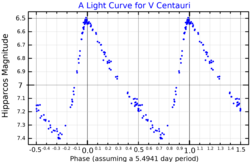
W Sagittarii is a multiple star system star in the constellation Sagittarius, and a Cepheid variable star.

X Sagittarii is a variable star and candidate binary star system in the southern constellation of Sagittarius, near the western constellation boundary with Ophiuchus. It has a yellow-white hue and is visible to the naked eye with an apparent visual magnitude that fluctuates around 4.54. The star is located at a distance of approximately 950 light years from the Sun based on parallax, and is drifting closer with a radial velocity of −10 km/s. The star has an absolute magnitude of around −2.85.

RT Aurigae is a yellow supergiant variable star in the constellation Auriga, about 1,500 light years from Earth.

2 Centauri is a single star in the southern constellation of Centaurus, located approximately 183 light-years from Earth. It has the Bayer designation g Centauri; 2 Centauri is the Flamsteed designation. This object is visible to the naked eye as faint, red-hued star with an apparent visual magnitude of 4.19. It is moving away from the Earth with a heliocentric radial velocity of +41 km/s. The star is a member of the HR 1614 supercluster.
HD 113703, also known by the Bayer designation f Centauri, is a multiple star system in the southern constellation of Centaurus. The combined apparent visual magnitude of this system is +4.71, which is sufficient to make it faintly visible to the naked eye. The distance to this system is approximately 400 light years based on parallax measurements. It is a member of the Lower Centaurus Crux subgroup of the Scorpius–Centaurus association.

Omicron1 Centauri is a star in the constellation Centaurus. It is approximately 10,000 light years from Earth.

R Centauri is a Mira variable star in the constellation Centaurus.

Zeta Cephei is a star in the constellation of Cepheus. Zeta Cephei marks the left shoulder of Cepheus, the King of Joppa (Ethiopia). It is one of the fundamental stars of the MK spectral sequence, defined as type K1.5 Ib.

HD 95109 is a Classical Cepheid variable, a type of variable star, in the constellation Carina. Its apparent magnitude is 6.86.
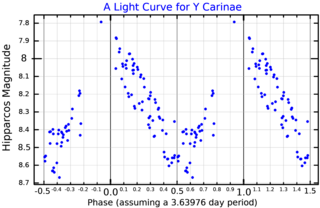
Y Carinae is a Classical Cepheid variable, a type of variable star, in the constellation Carina. Its apparent magnitude varies from 7.53 to 8.48.
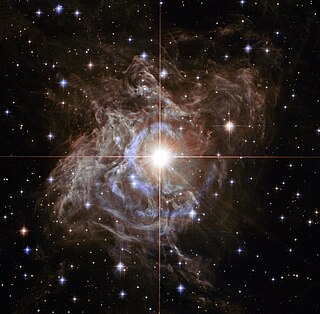
RS Puppis is a Cepheid variable star around 6,000 ly away in the constellation of Puppis. It is one of the biggest and brightest known Cepheids in the Milky Way galaxy and has one of the longest periods for this class of star at 41.5 days.
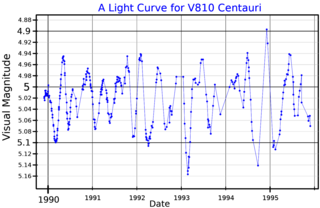
V810 Centauri is a double star consisting of a yellow hypergiant primary and blue giant secondary. It is a small amplitude variable star, entirely due to the supergiant primary which is visually over three magnitudes brighter than the secondary. It is the MK spectral standard for class G0 0-Ia.

V4381 Sagittarii is a variable star in the constellation Sagittarius. A white supergiant of spectral type A2/A3Iab, it is an Alpha Cygni variable that varies between apparent photographic magnitudes 6.57 and 6.62. Its visual apparent magnitude is about 6.54.

Sigma Ophiuchi, Latinized from σ Ophiuchi, is a single, orange-hued star in the equatorial constellation Ophiuchus. Its apparent visual magnitude is 4.31, which is bright enough to be faintly visible to the naked eye. The annual parallax shift of 3.62 mas as seen from Earth provides a distance estimate of roughly 900 light years. It is moving closer to the Sun with a radial velocity of −28 km/s.

QZ Puppis is a class B2.5V star in the constellation Puppis. Its apparent magnitude is 4.5 and it is approximately 650 light years away based on parallax.

Y Centauri or Y Cen is a semiregular variable star in the constellation of Centaurus.

S Muscae is a classical (δ) Cepheid variable star in the constellation Musca about 2,600 light years away.

SV Vulpeculae is a classical Cepheid variable star in the constellation Vulpecula. It is a supergiant at a distance of 8,700 light years.

V3903 Sagittarii is an eclipsing binary star system in the constellation Sagittiarus. It creates an H II region LBN 29 1,070 parsecs away from the Sun.
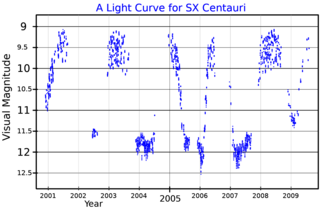
SX Centauri is a variable star in the constellation Centaurus. An RV Tauri variable, its light curve alternates between deep and shallow minima, varying its apparent magnitude from 9.1 to 12.4. From the period-luminosity relationship, it is estimated to be around 1.6 kpc from Earth. Gaia Data Release 2 gives a parallax of 0.2175 mas, corresponding to distance of about 4,600 pc.
